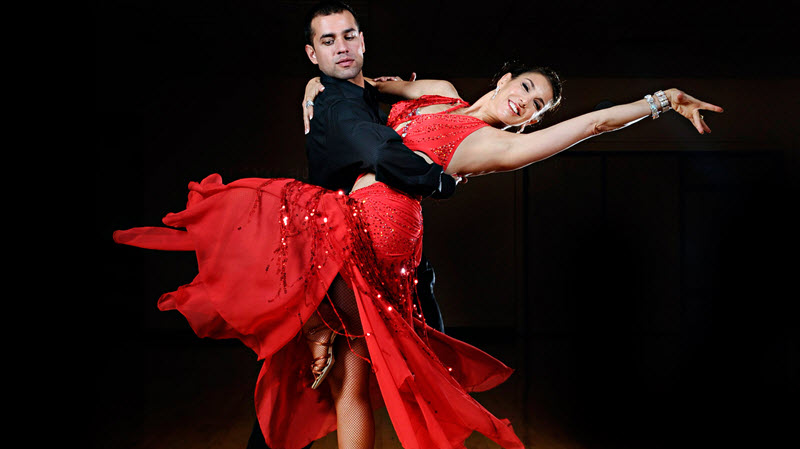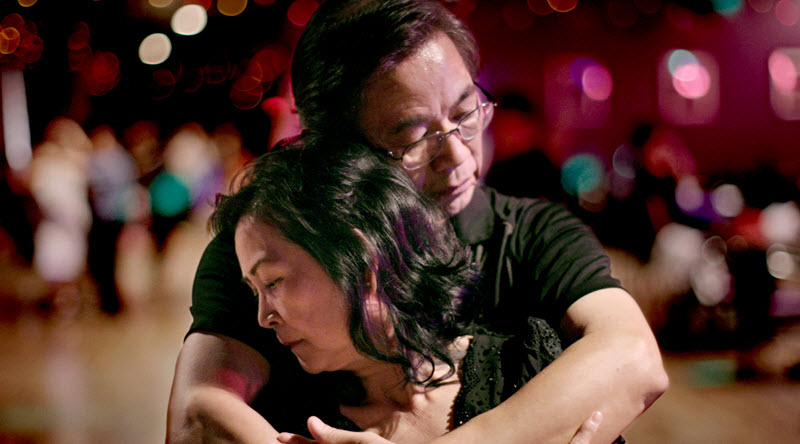
Cha-cha-cha dancing
Cha-cha-cha is a dance that developed in Cuba in the 1950s.
Original Cuban cha-cha-cha, and the one used in ballroom competions, counts “one, two, three, cha-cha” or “one, two, three, four-and”. Among casual contemporary dancers, there has been a shift over to “one, two, cha-cha-cha” which shifts the timing by a full beat.
Cha-cha-cha features the typical Latin dance hip movement, which can be achieved through the alternate bending and straightening action of the knees. In competitive cha-cha-cha dancing, however, the weighted leg is almost always kept straight, and only the free leg bends. This makes the hips settle in the direction of the weighted leg. The free leg will straighten just before receiving weight again, and will stay straight as long as it is weighted.
Music
Traditionalists dance cha-cha-cha to Cuban cha-cha-cha music. In ballroom competions, it is common to break with tradition and dance to Latin pop or Latin rock music.
Why is it called cha-cha-cha?
Because that´s the sound of the cha-cha-cha dancers´ feet when they dance two consecutive quick steps.
The basic footwork pattern of cha-cha-cha links it to several Afro-Cuban dances found within to the syncretic religion Santería. These dances were familiar to many Cubans in the 1950s when cha-cha-cha developed on the island, and people within the Afro-Cuban community were especially likely to know them.
Ballroom cha-cha-cha
Cha-cha-cha is one of the five dances that comprise the Latin American program in international ballroom competitions.
A notable characteristic of the modern ballroom cha-cha-cha is the scarcity of rise and fall, and how the steps tend to be kept compact.
Background
The music of the Cuban composer and violinist Enrique Jorrin was very important for the development of this dance in the early 1950s, and he, in turn, borrowed the characteristic rhythm from the danzón-mambo when he created his cha-cha-cha music. As mentioned above, there are also ties between cha-cha-cha steps and Cuban Santería dances.
Enrique Jorrín worked in Havan dance halls as a part of the charanga group Orquestra América, which played danzon-mambo, danzonete and danzón music. Jorrín noticed that many dancers found the syncopated rhythms of the danzón-mambo difficult to handle, so he started creating danzón-mambo inspired songs with less syncopation, where the melody was marked strongly on the first downbeat.
It was dancers at Havana´s Silver Star Club that improvised a triple step when dancing to Jorrín´s new music. Their footwork produced the characteristic cha-cha-cha sound, and the new music and associated dance style became known locally as cha-cha-cha.

Dance steps
Cha-cha-cha dance steps according to the American School of Ballroom Dance
In this school, the basic cha-cha-cha step spans two measures of music. Count “one, two, three, four-and, five, six, seven, eight-and” and start the second measure on five.
- Count one: The leader steps sideways to the left
- Count two: The leader steps back and puts weight on his right foot
- Count three: The leader steps forward with his left foot
- Count four-and: The leader steps sideways to the right on count four, followed by a step in place on the left food on “and”
- Count five (which is the first count of the second measure): The leader does another step sideways to the right
- Count six: The leader steps forward with his left foot
- Count seven: The leader steps backwards with his right foot
- Count eight-and: The leader does a cha-cha to the left
A step sideways to the left begins the next repetition